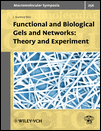Polymethacrylate Networks as Substrates for Cell Culture
Abstract
Summary: methacrylate networks have a long history of applications in medical technology and much is known of their non-fouling properties. However, in recent times it has become clear that the swollen nature of these materials may provide some advantages if they are used as scaffolds in tissue engineering. In general however these hydrogels are resistant to protein adsorption and human cells do not easily adhere. In this work we provide an overview of several strategies that are designed to improve the cell-adhesive properties of hydrogels while maintaining their useful properties, mainly ease of diffusion of nutrients and growth factors. We describe our early attempts at modifying hydrogels based on 2,3-propandiol -1-methacrylate, with either hydrophobic units or acid groups. Modification with lauryl methacrylate produced an improvement but acid modification failed to provide surfaces that were conducive to cell culture. Much better scaffolds were prepared by amination of epoxy functional 2,3-propandiol-1-methacrylate networks. Optimized materials in this class were shown to be good substrates for the co-culture of bovine keratocytes with human corneal epithelial cells. We also describe the synthesis and biological properties of methacrylate conetworks, which phase separate during synthesis to give porous amphiphilic materials. Optimization of these materials produces materials that perform as well as tissue culture plastic so that confluent sheets of human dermal fibroblasts can be produced using standard culture techniques.




